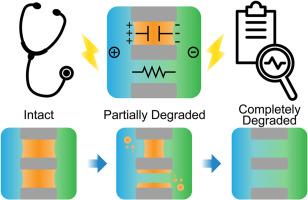利用电化学阻抗谱对支撑液体膜进行实时无损监测
IF 9
1区 工程技术
Q1 ENGINEERING, CHEMICAL
引用次数: 0
摘要
膜液浸出导致的支撑液体膜(SLMs)降解一直是其从废物流中进行资源回收的障碍。我们提出了一种新方法,利用四电极模式电化学阻抗光谱(EIS)对 SLM 降解进行实时、无损监测,提供 SLM 结构变化的详细分析。我们首先通过 EIS 发现 SLM 可被描述为电阻器和电容器组成的电路。然后,通过 EIS 发现,由于 SLM 的厚度和面积减小的速度不同,SLM 退化经历了四个不同的阶段。为了证明基于 EIS 诊断的有效性,我们制备了用于选择性提取中链脂肪酸 (MCFA) 的 SLM,并通过 EIS 确定了其完整、部分和完全降解的状态。与短链脂肪酸相比,完整的 SLM 对 MCFA 具有较高的选择性(50 ∼ 50)。在部分降解的 SLM 中,选择性降至 ∼22,而在完全降解的 SLM 中,选择性低于 1,这表明降解程度与分离性能之间存在明显的联系。我们的四电极模式 EIS 方法有望成为高效 SLM 运行和稳定 SLM 开发的关键工具。本文章由计算机程序翻译,如有差异,请以英文原文为准。

Real-time non-destructive monitoring of supported liquid membranes using electrochemical impedance spectroscopy
The degradation of supported liquid membranes (SLMs) due to membrane liquid leaching has been a hurdle for their implementation in resource recovery from waste streams. We present a novel approach utilizing four-electrode mode electrochemical impedance spectroscopy (EIS) for real-time, non-destructive monitoring of SLM degradation, providing detailed analysis of SLM's structural changes. We first showed that SLMs may be depicted as an electrical circuit of resistors and capacitors by EIS. The EIS then revealed that SLM degradation progressed over four different phases as a result of varying rates of thickness and area reduction of the SLM. To demonstrate the effectiveness of EIS-based diagnosis, we prepared SLMs designed for selective medium-chain fatty acid (MCFA) extraction in intact, partially, and completely degraded states, determined by the EIS. The intact SLM showed a high selectivity (∼50) for MCFAs over short-chain fatty acids. The selectivity decreased to ∼22 in the partially degraded SLMs, and less than 1 in the completely degraded SLM, indicating the clear linkage between the degree of degradation and the separation performance. Our four-electrode mode EIS method is expected to serve as a key tool for efficient SLM operation and stable SLM development.
求助全文
通过发布文献求助,成功后即可免费获取论文全文。
去求助
来源期刊

Journal of Membrane Science
工程技术-高分子科学
CiteScore
17.10
自引率
17.90%
发文量
1031
审稿时长
2.5 months
期刊介绍:
The Journal of Membrane Science is a publication that focuses on membrane systems and is aimed at academic and industrial chemists, chemical engineers, materials scientists, and membranologists. It publishes original research and reviews on various aspects of membrane transport, membrane formation/structure, fouling, module/process design, and processes/applications. The journal primarily focuses on the structure, function, and performance of non-biological membranes but also includes papers that relate to biological membranes. The Journal of Membrane Science publishes Full Text Papers, State-of-the-Art Reviews, Letters to the Editor, and Perspectives.
 求助内容:
求助内容: 应助结果提醒方式:
应助结果提醒方式:


